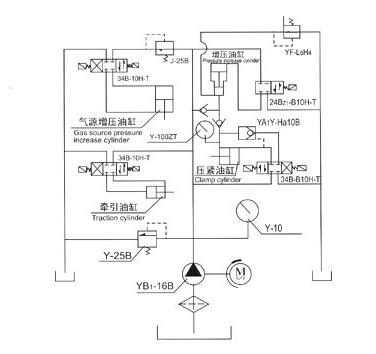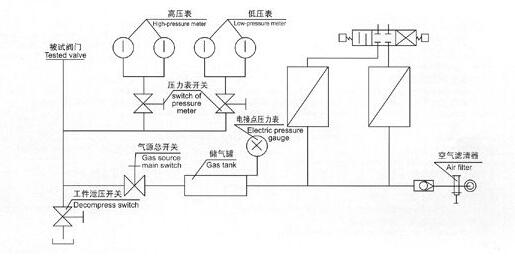JLA safety valve performance test bench is in accordance with the national GB / T1 3927 - 92 "universal valve pressure test" and ZBJl6006-90 "valve testing and testing" of the standard specification requirements, the test station eliminates the traditional large channeling volume Of the high-pressure gas tank, just equipped with ordinary 0.6MPa air pump gas source. After this opportunity to automatically adjust 0.6-32.0MPa gas medium test pressure. Suitable nominal diameter DNl 5 ~ 300mm tuning valve, opening and closing the back seat and the sealing operation or the like pressure performance test. With stable performance, easy to use, high degree of automation of the test data is correct and so on.
JLA safety valve performance test bench working principle and structure
JLA-type safety valve performance test bench set machine, electricity, liquid in one, with gas as the test medium, liquid gas linkage pressure, with multi-polar boost device system, the function to meet the test pressure required for work. Workpiece clamping the valve flange by the end of the valve for the positioning of the hydraulic cylinder clamping jaw clamping flange on the back of the clamping method. No additional external force on the tested valve, in full compliance with national standards related to the valve test requirements.
The machine consists of hydraulic system, mechanical components, electrical control and multi-polar air source pressure booster system components. Hydraulic system is the main source of this test bench. For all types of hydraulic cylinder and mechanical drive implementation. The test surface jaws are directly driven by the hydraulic cylinder. The axial clamping pressure is adjusted according to the test pressure level of the valve (the maximum hydraulic pressure is 31 5MPa). Each jaw are force, clamping and reliable. Radial movement by the hydraulic cylinder drive implementation, each jaw advance and retreat synchronization, flexibility, to ensure that the size of the valve diameter test. Multi-polar air source boost device is the use of liquid-gas linkage pressure. Boosting range of 0.6-32 0MPa, for the valve medium pressure test. Air pressure booster operation with automatic and manual control of two operating options, the election of automatic boost work, the staff can leave the console close observation of field test conditions.
The test bench in the use of gas pressure in the use of safety devices from the gas pressure booster control valve control, electrical contact pressure gauge specified downtime.
JLA safety valve performance test bench Notes and safety requirements:
First, JLA-type safety valve performance test bench installation, the hydraulic control system and the workbench should be a certain distance, apart from the position of not less than 500mm, the school level of installation, with concrete anchor foot bolts.
Second, with 30-40 # hydraulic oil into the tank, the fuel can not be lower than the lower limit of the oil level gauge.
Third, turn on the power, press the pump start button, check the motor rotation direction is correct (clockwise), the pump pressure is adjusted at 5.0MPa, test machine, check the pipeline connector is no leakage and other noises, found the phenomenon , Should be immediately overhaul.
Fourth, the test valve, the first test should be based on the valve test requirements, refer to "clamping cylinder pressure required table" for the required pressure booster adjustment. No supercharged work supercharged to prevent damage to the subjects valve deformation.
Fifth, the gas source boost work before the first electric contact pressure gauge pointer set in the test valve required test pressure position, high pressure test reference to the "liquid-gas pressure regulator table", and then boost the work pressure To meet the specified requirements, the pump automatically stop working.
Sixth, the daily use of the air filter to check the discharge, drain pipe on the storage tank L, weekly to regularly check emissions.
Seven test bench test the valve disc and the sealing contact surface, clean dry; contention, does not allow oil and other debris, the test station is prohibited in the art by the use of near work process.
Eight, replace the hydraulic oil to regularly check for new fluid injected in 5-6 months should be cleaned and oil filter tank simultaneously replaced with new oil, oil tank temperature must not exceed 60 ℃.
Nine, non-compliance over-pressure operation.
JLA safety valve performance test bench appearance
JLA safety valve performance test bench to use and operating procedures:
First, the compression: Jog button (radial out), select and seal the valve adaptation, placed in the center of the workbench, the test valve placed on the seal plate. Click to press
Push the button in (radially in) to move the pressure jaw to the desired position on the valve flange and press the button (axial compression).
Second, booster: In accordance with the "clamping pressure required table" nominal diameter (DN), nominal pressure PN booster. Press the button (axial boost) while adjusting the axial boost pressure
The valve will booster pressure rose to the required pressure in the table, (Note: Pressurized button can be a number of jogging, each time interval if 5-10 seconds).
Third, the gas source pressure: hydraulic clamping, pressurization after all. Open the needle valve gas source switch (work into the air) and then open the toggle switch (automatic, manual) in the automatic gas source
Pressurized state selected pressure gauge, high pressure and low pressure, if it is high pressure, turn off the low pressure gauge switch, adjust the electrical contact pressure gauge to adapt to pressure, and f gas source pressure regulator
valve).
Fourth, the test valve inlet pressure increases, when the pressure reaches 90% of the set pressure, the boost speed should not exceed O. 01MPa, observe and record the test valve pressure setting
force. Then reduce the inlet pressure of the valve so that the tested valve can be returned to airtight state. Regulate valve inlet pressure and keep it at seal test pressure. Check valve sealing performance.
Fifth, the pressure relief valve: when the test valve test is completed, and off (automatic, manual) switch, turn off (gas source switch), open the relief needle valve work pressure relief, to no pressure
When the force can relax the workpiece.
JLA hydraulic schematic 
JLA type electrical system schematic

Pressure system diagram
Tungsten carbide welding bars are commonly used in the oil and gas industry for various applications. These bars are made from a combination of tungsten and carbon, which results in a very hard and wear-resistant material. Here are some specific uses of tungsten carbide welding bars in the oil and gas industry:
1. Hardfacing: Tungsten carbide welding bars are used for hardfacing applications, where a wear-resistant layer is applied to drilling tools, valves, pumps, and other equipment exposed to abrasive environments. This helps to extend the lifespan of the components and reduce maintenance costs.
2. Drill bits: Tungsten carbide welding bars are used to manufacture drill bits for oil and gas exploration. The hard and durable nature of tungsten carbide makes it ideal for drilling through tough rock formations.
3. Wear plates and liners: Tungsten carbide welding bars are used to create wear plates and liners for equipment used in oil and gas production. These plates and liners protect the underlying metal surfaces from abrasion and corrosion, ensuring the longevity of the equipment.
4. Valve seats and seals: Tungsten carbide welding bars are used to manufacture valve seats and seals for oil and gas valves. The high hardness and wear resistance of tungsten carbide ensure reliable sealing and prevent leakage in critical applications.
5. Downhole tools: Tungsten carbide welding bars are used in the manufacturing of downhole tools such as stabilizers, reamers, and drill collars. These tools are subjected to high pressures, temperatures, and abrasive conditions, and tungsten carbide helps to enhance their durability and performance.
Overall, tungsten carbide welding bars play a crucial role in the oil and gas industry by providing wear resistance, hardness, and durability to various components and equipment.
Welding Bar,Ni Based Welding Bar,Ni Based Ctc Welding Bar,Sctc Ni Based Welding Bar
Luoyang Golden Egret Geotools Co., Ltd , https://www.xtcmetalpowder.com